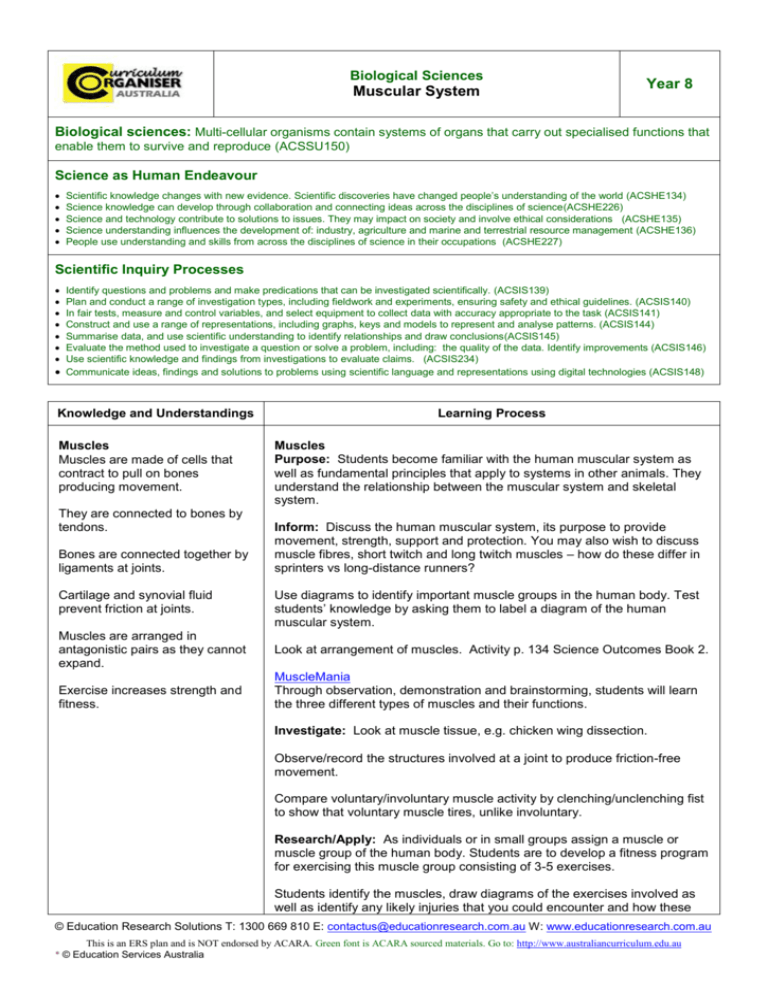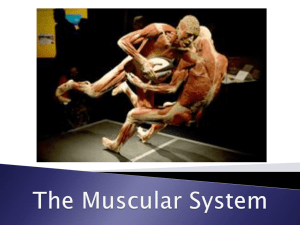Muscular system - Biology - Year 8
advertisement

Biological Sciences Muscular System Year 8 Biological sciences: Multi-cellular organisms contain systems of organs that carry out specialised functions that enable them to survive and reproduce (ACSSU150) Science as Human Endeavour Scientific knowledge changes with new evidence. Scientific discoveries have changed people’s understanding of the world (ACSHE134) Science knowledge can develop through collaboration and connecting ideas across the disciplines of science(ACSHE226) Science and technology contribute to solutions to issues. They may impact on society and involve ethical considerations (ACSHE135) Science understanding influences the development of: industry, agriculture and marine and terrestrial resource management (ACSHE136) People use understanding and skills from across the disciplines of science in their occupations (ACSHE227) Scientific Inquiry Processes Identify questions and problems and make predications that can be investigated scientifically. (ACSIS139) Plan and conduct a range of investigation types, including fieldwork and experiments, ensuring safety and ethical guidelines. (ACSIS140) In fair tests, measure and control variables, and select equipment to collect data with accuracy appropriate to the task (ACSIS141) Construct and use a range of representations, including graphs, keys and models to represent and analyse patterns. (ACSIS144) Summarise data, and use scientific understanding to identify relationships and draw conclusions(ACSIS145) Evaluate the method used to investigate a question or solve a problem, including: the quality of the data. Identify improvements (ACSIS146) Use scientific knowledge and findings from investigations to evaluate claims. (ACSIS234) Communicate ideas, findings and solutions to problems using scientific language and representations using digital technologies (ACSIS148) Knowledge and Understandings Muscles Muscles are made of cells that contract to pull on bones producing movement. They are connected to bones by tendons. Bones are connected together by ligaments at joints. Cartilage and synovial fluid prevent friction at joints. Muscles are arranged in antagonistic pairs as they cannot expand. Exercise increases strength and fitness. Learning Process Muscles Purpose: Students become familiar with the human muscular system as well as fundamental principles that apply to systems in other animals. They understand the relationship between the muscular system and skeletal system. Inform: Discuss the human muscular system, its purpose to provide movement, strength, support and protection. You may also wish to discuss muscle fibres, short twitch and long twitch muscles – how do these differ in sprinters vs long-distance runners? Use diagrams to identify important muscle groups in the human body. Test students’ knowledge by asking them to label a diagram of the human muscular system. Look at arrangement of muscles. Activity p. 134 Science Outcomes Book 2. MuscleMania Through observation, demonstration and brainstorming, students will learn the three different types of muscles and their functions. Investigate: Look at muscle tissue, e.g. chicken wing dissection. Observe/record the structures involved at a joint to produce friction-free movement. Compare voluntary/involuntary muscle activity by clenching/unclenching fist to show that voluntary muscle tires, unlike involuntary. Research/Apply: As individuals or in small groups assign a muscle or muscle group of the human body. Students are to develop a fitness program for exercising this muscle group consisting of 3-5 exercises. Students identify the muscles, draw diagrams of the exercises involved as well as identify any likely injuries that you could encounter and how these © Education Research Solutions T: 1300 669 810 E: contactus@educationresearch.com.au W: www.educationresearch.com.au This is an ERS plan and is NOT endorsed by ACARA. Green font is ACARA sourced materials. Go to: http://www.australiancurriculum.edu.au * © Education Services Australia could be avoided. [Could be performance/video/multimedia presentation] Evaluation: Discuss how the muscular system and skeletal system work together to provide movement. What attaches muscles to bones? Highlight that muscles can only contract and never push so they must always be ‘antagonistic’ muscle pairs. Have students create a model of a major skeletal muscle group as outlined in the activity below. Know Bones About It Activity: Students make a model of a major skeletal muscle group. They then consider how their life might change if they didn’t have, or lack use of, this particular muscle group. L725 Body parts: muscles Learning Object Education Services Australia The Le@rning Federation Look closely at major muscles in the human body. Find out which muscles control functions such as smiling, moving arms and legs, and pumping food through the body. See how muscles contract and relax. Test your knowledge by answering multiple-choice questions. This learning object is one in a series of 14 objects. * http://www.scootle.edu.au/ec/objectLink.action?action=content&id=L725 Assessment: Students label a diagram of the human muscular system Student produce a report or multimedia presentation covering 3-5 exercises for a particular muscle group Students create a model of a major muscle group. Standards http://www.australiancurriculum.edu.au/Science/Curriculum/F-10?y=8&s=SU&s=HE&s=IS&layout=1 Teacher Resources IWB T Muscular System Menu - info and interactive sites Muscular System (Front View) Interactive with animations Muscular System Diagram with info, further web sites and resources The Strength of the Muscular System Students use microscope slides to learn about the difference between voluntary and involuntary muscles. Student Resources IWB S Yahoo Kids! Anatomy The Visible Human Project This site contains numerous anatomically detailed photographs and 3D representations of the human body. Click on "A sampler of images and animations from the Project" to see an animated trip through the Visible Human male body. Exploratorium: Revealing Bodies Move the slider to look inside the human body and see where different organs and systems are located. © Education Research Solutions T: 1300 669 810 E: contactus@educationresearch.com.au W: www.educationresearch.com.au This is an ERS plan and is NOT endorsed by ACARA. Green font is ACARA sourced materials. Go to: http://www.australiancurriculum.edu.au * © Education Services Australia Lesson Planner Lesson Teacher Notes Student Activities Resources Title: 1 Date Time Title: 2 Date Time Title: 3 Date Time Title: 4 Date Time Title: 5 Date Time © Education Research Solutions T: 1300 669 810 E: contactus@educationresearch.com.au W: www.educationresearch.com.au This is an ERS plan and is NOT endorsed by ACARA. Green font is ACARA sourced materials. Go to: http://www.australiancurriculum.edu.au * © Education Services Australia









